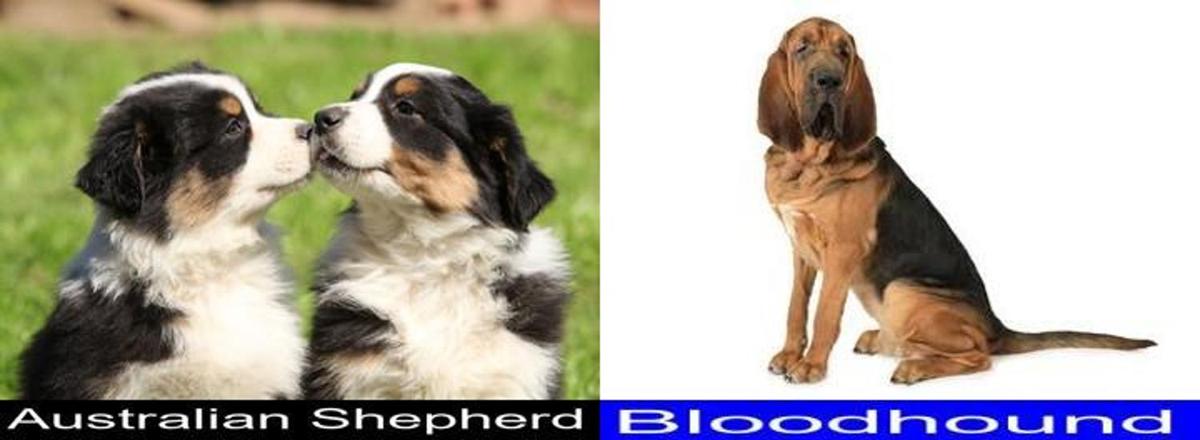Last Updated: Jun 15, 2022
Quick Links: Table of Contents
- Australian Shepherd Versus Bloodhound: Introduction
- Australian Shepherd versus Bloodhound: Overview
- Australian Shepherd versus Bloodhound: Comparison Table
- The Most Remarkable Differences Between the Australian Shepherd and the Bloodhound
- The Similarities Between the Australian Shepherd and the Bloodhound
- Size Comparison of the Australian Shepherd versus Bloodhound
- Appearance (Colors) of the Australian Shepherd and the Bloodhound
- Lifespan of Australian Shepherd versus Bloodhound
- Temperament of the Australian Shepherd Versus the Bloodhound
- Price of Australian Shepherd versus Price of Bloodhound
- Adopting the Australian Shepherd versus Adopting the Bloodhound
- The Popularity of Australian Shepherd versus Popularity of Bloodhound
- Health Problems of Australian Shepherd versus Health Problems of Bloodhound
- Tolerates Being Alone: Australian Shepherd versus Bloodhound
- Do Australian Shepherds shed more than Bloodhounds?
- Which is Easier to Groom, the Australian Shepherd or the Bloodhound?
- Which Dog Breed is more Dog-Friendly, the Australian Shepherd or the Bloodhound?
- Are Australian Shepherds good family dogs? What about Bloodhounds?
- Is the Australian Shepherd Easier to Train than the Bloodhound?
- Which one drools more, the Australian Shepherd or the Bloodhound
- How Kid-friendly are Australian Shepherds and Bloodhounds?
- Does the Australian Shepherd Have a Higher Prey Drive than the Bloodhound?
- Do Australian Shepherds Bark and Howl? What about Bloodhounds?
- Can Australian Shepherds Tolerate Cold Weather? And can Bloodhounds Tolerate Cold Weather?
- Wanderlust Potential: Australian Shepherd vs. Bloodhound
- Can Australian Shepherds Tolerate Hot Weather? Can Bloodhounds Tolerate Hot Weather?
- Australian Shepherd Versus Other Dog Breeds
- Conclusion: Australian Shepherd versus Bloodhound. Which One is a Better Pet?
Australian Shepherd Versus Bloodhound: Introduction
Are you thinking of getting a new pet dog, and you have narrowed down your choices to the Australian Shepherd and the Bloodhound? Well, you have come to the right place. Because in this article, we will provide you with a detailed comparison of these two dog breeds to help you decide which of the Australian Shepherd and the Bloodhound better suits you.
We will provide you a detailed discussion and comparison of dog attributes such as intelligence, price, general health, friendliness, etc, for both the Australian Shepherd and the Bloodhound.
Furthermore, we will let you know which one of the Australian Shepherd and the Bloodhound is better suited for new dog owners, for owners with kids, for owners that live in apartments, for owners with dog allergies, etc.
Importantly, we did some analysis and calculation and we obtained a number that we call the Better-Pet Score™ for both the Australian Shepherd and for the Bloodhound. The dog breed with the higher Better-Pet score is the `better` pet. We hope that these Better-Pet Scores will provide you with more insight into deciding which pet to get between the Australian Shepherd and the Bloodhound.
Our only goal here is to help you make a well-thought-out decision on your next long-term companion, be it the Australian Shepherd or the Bloodhound.

Australian Shepherd versus Bloodhound: Overview
A very important difference between the Australian Shepherd and the Bloodhound is the size difference between the two dog breeds. The Australian Shepherd is a medium-sized dog while the Bloodhound is a large-sized dog.
Furthermore, the Australian Shepherd belongs to the Herding Dogs group. Herding Dogs were bred for moving livestock, including sheep, cattle, and even reindeer. Herding dogs work closely with their human shepherds, and their natural intelligence and responsiveness make them highly trainable. They have high levels of energy, which needs to be channeled properly to prevent destructive behavior. Herding breeds are protective of their people and property and make excellent watchdogs. Their intelligence, agility, and activity level make them well suited to dog sports.
On the other hand, the Bloodhound belongs to the Hound Dogs group. Hound Dogs were bred to pursue and hunt warm-blooded animals. Hounds hunt by using their good sight or their good sense of smell. Dogs that belong to the Hound Group have strong prey drives and often will stop at nothing to catch what they are pursuing.
Australian Shepherd versus Bloodhound: Comparison Table
The table below compares the Australian Shepherd to the Bloodhound based on different important factors such as Price, Health, Kid-friendliness, etc.
When a dog breed scores higher for a factor than the other dog breed, the box of the breed that scores higher is shaded green and the box of the breed that scores lower is shaded red. When there is no difference between the breeds for a particular factor then the box is shaded gray for both pets. Also, when the factor is not important in picking a pet, or when the factor cannot be compared between two pets, the box for the factor is shaded gray for both pets
Most of the factors in the table for each dog breed are ranked on a scale of 1 to 5. “1” means “worst”, and “5” means “best”.
However, some factors such as “Price”, “Average Lifespan”, etc. cannot be on a scale of 1 to 5, so they are not on a scale of 1 to 5 in the comparison table.
Later in this article, we will further explain each factor as it applies to the Australian Shepherd and the Bloodhound
| Factor | Australian Shepherd | Bloodhound |
|---|---|---|
| Adapts Well To Apartment Living | 1/5 | 1/5 |
| Does NOT Drool | 5/5 | 1/5 |
| Easy To Groom | 1/5 | 1/5 |
| Life Span | 12 to 15 years | 11 to 15 years |
| Height | 18 to 23 inches tall at the shoulder | 23 to 27 inches ttall at the shoulder |
| Good For Novice Owners | 2/5 | 2/5 |
| Tolerates Being Alone | 2/5 | 2/5 |
| General Health | 2/5 | 3/5 |
| Friendly Toward Strangers | 3/5 | 5/5 |
| Does NOT Shed | 3/5 | 2/5 |
| Tolerates Cold Weather | 4/5 | 3/5 |
| Tolerates Hot Weather | 4/5 | 3/5 |
| Kid-Friendly | 4/5 | 5/5 |
| Potential NOT to Gain Weight | 2/5 | 3/5 |
| Does NOT chew on things | 2/5 | 1/5 |
| Low Prey Drive | 2/5 | 3/5 |
| Does NOT Bark or Howl | 2/5 | 2/5 |
| Calmness/ Low Vigor | 2/5 | 2/5 |
| Weight | 40 to 65 pounds | 80 to 110 pounds |
| Easygoing | 1/5 | 2/5 |
| Affectionate With Family | 5/5 | 5/5 |
| Dog Friendly | 5/5 | 5/5 |
| Easy To Train | 5/5 | 3/5 |
| Intelligence | 5/5 | 4/5 |
| Tendency NOT to Wander | 1/5 | 1/5 |
| NOT Rambunctious | 1/5 | 1/5 |
| Minimal Exercise Needs | 1/5 | 1/5 |
| Potential For Playfulness | 5/5 | 3/5 |
| Average Lifespan | 13.5 years | 13.0 years |
| Average Price | $1180 | $880 |
| Price Range | $800 – $1500 | $650 – $1000 |
| Temperament Score | 82.2 percent | 75.0 percent |
| Common Health Problems and Recommended Health Tests | ||
| Popularity out of 200 Dog Breeds | 15 | 49 |
Next, we added the scores of the factors that can be added together for the Australian Shepherd in the table (that is, `Ease of Grooming` score + `General Health` score + `Calmness` score + …etc) and we compared it to the corresponding total score for the Bloodhound. We call these total scores the Better-Pet Scores, as we mentioned earlier. We called this score the Better-Pet score because the better dog breed will have a higher score. This is because the pet will the higher score will have minimal needs and be easier to have as a pet.
The Better-Pet score for the Australian Shepherd is 70 out of 125 while the Better-Pet score for the Bloodhound is 64 out of 125.
Based on their Better-Pet scores, the Australian Shepherd is a better pet than the Bloodhound. So, you should get a Australian Shepherd!

The Most Remarkable Differences Between the Australian Shepherd and the Bloodhound
Below is a list of where the Australian Shepherd and the Bloodhound are most different:
The Similarities Between the Australian Shepherd and the Bloodhound
The Australian Shepherd and the Bloodhound are very similar in certain aspects. Below is the list of where the Australian Shepherd and the Bloodhound are most similar:
Size Comparison of the Australian Shepherd versus Bloodhound
Now, let us discuss the difference in size between the Australian Shepherd and the Bloodhound.
The Australian Shepherd weighs 40 to 65 pounds when fully grown. The Australian Shepherd is 18 to 23 inches tall at the shoulder when fully grown.
On the other hand, the Bloodhound weighs 80 to 110 pounds when fully grown. The Bloodhound is 23 to 27 inches ttall at the shoulder when fully grown.

Appearance (Colors) of the Australian Shepherd and the Bloodhound
Australian Shepherd Colors
The Australian Shepherd comes in the following beautiful primary colors:
- Brown / Chocolate
- Tricolor (Brown, Black, & White)
- Black
- Merle (Red)
- Gray / Blue / Silver
- Red / Chestnut / Orange
- Yellow / Tan / Blond / Fawn
- Harlequin
- Merle (Blue)
- White / Cream
- Apricot / Beige
- Bicolor
- Golden
- Brindle
The Australian Shepherd comes in the following lovely secondary colors in addition to its primary colors:
- White / Cream
- Brown / Chocolate
- Yellow / Tan / Blond / Fawn
- Red / Chestnut / Orange
- Black
- Tricolor (Brown, Black, & White)
- Sable
- Gray / Blue / Silver
- Merle (Blue)
Bloodhound Colors
The Bloodhound comes in the following beautiful primary colors:
- Brown / Chocolate
- Yellow / Tan / Blond / Fawn
- Red / Chestnut / Orange
- Bicolor
- Black
- Apricot / Beige
- Brindle
- White / Cream
- Tricolor (Brown, Black, & White)
The Bloodhound comes in the following lovely secondary colors in addition to its primary colors:
- Brown / Chocolate
- White / Cream
- Black
- Bicolor
- Yellow / Tan / Blond / Fawn
- Red / Chestnut / Orange
Lifespan of Australian Shepherd versus Bloodhound
The lifespan of the Australian Shepherd is between 12 to 15 years. The average lifespan of the Australian Shepherd is 13.5 years.
The lifespan of the Bloodhound is between 11 to 15 years. The average lifespan of the Bloodhound is 13.0 years.
The Australian Shepherd live longer than the Bloodhound.
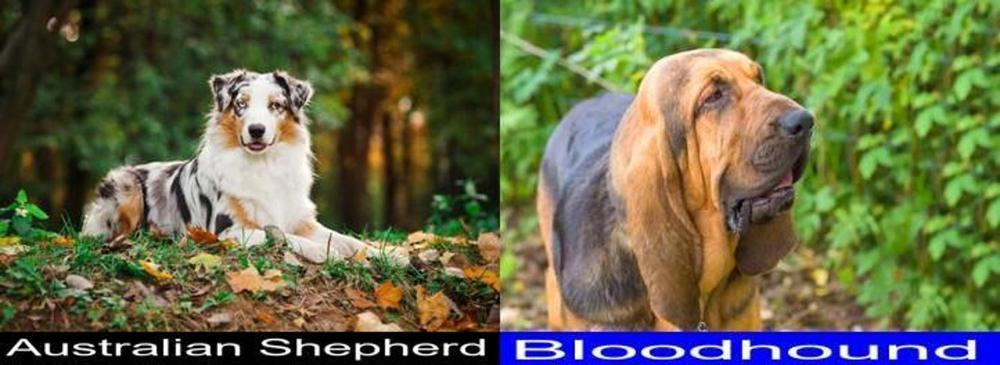
Temperament of the Australian Shepherd Versus the Bloodhound
The Australian Shepherd has a better temperament than the Bloodhound.
This is because the temperament score for the Australian Shepherd is 82.2 percent while the temperament score for the Bloodhound is 75.0 percent, according to the American Temperament Test Society (ATTS).
The American Temperament Test Society (ATTS) is a non-profit organization whose mission is to provide fair and objective evaluations of the temperaments of dog breeds.
Dog breeds with low temperament scores tend to show unprovoked aggression, they easily panic without quickly recovering from the panic, and they tend to avoid people. However, dog breeds with high temperament scores are not aggressive and are not shy. Also, these dogs are generally friendly and are protective of their owners.
The average temperament score across all dog breeds (over 250 breeds) is 83.7 percent.
With its temperament score of 82.2 percent, the Australian Shepherd has a below-average temperament compared to other dog breeds.
With its temperament score of 75.0 percent, the Bloodhound has a below-average temperament compared to other dog breeds.
The ATTS obtained the temperament scores of the Australian Shepherd and the Bloodhound by measuring the temperaments of 702 Australian Shepherds and 40 Bloodhounds.
Price of Australian Shepherd versus Price of Bloodhound
The average price of the Australian Shepherd puppy is $1180. The price of the Australian Shepherd typically ranges from $800 – $1500. However, the price of a Australian Shepherd can be as low as $100 and as high as $12009. We obtained this price information by reviewing the prices of 2674 Australian Shepherd puppies listed for sale from various sources.
The average price of the Bloodhound puppy is $880. The price of the Bloodhound typically ranges from $650 – $1000. However, the price of the Bloodhound can be as low as $250 and as high as $3400. We obtained this price information by collecting and reviewing the prices of 278 Bloodhound puppies listed for sale from various sources.
The Australian Shepherd is more expensive than the Bloodhound.
| Australian Shepherd | Bloodhound | |
|---|---|---|
| Average Price | $1180 | $880 |
| Price Range | $800 to $1500 | $650 to $1000 |
The charts below show the price distribution for the Australian Shepherd and Bloodhound. For different price points, the charts show how many Australian Shepherd puppies or how many Bloodhound puppies are listed for sale at those price points.
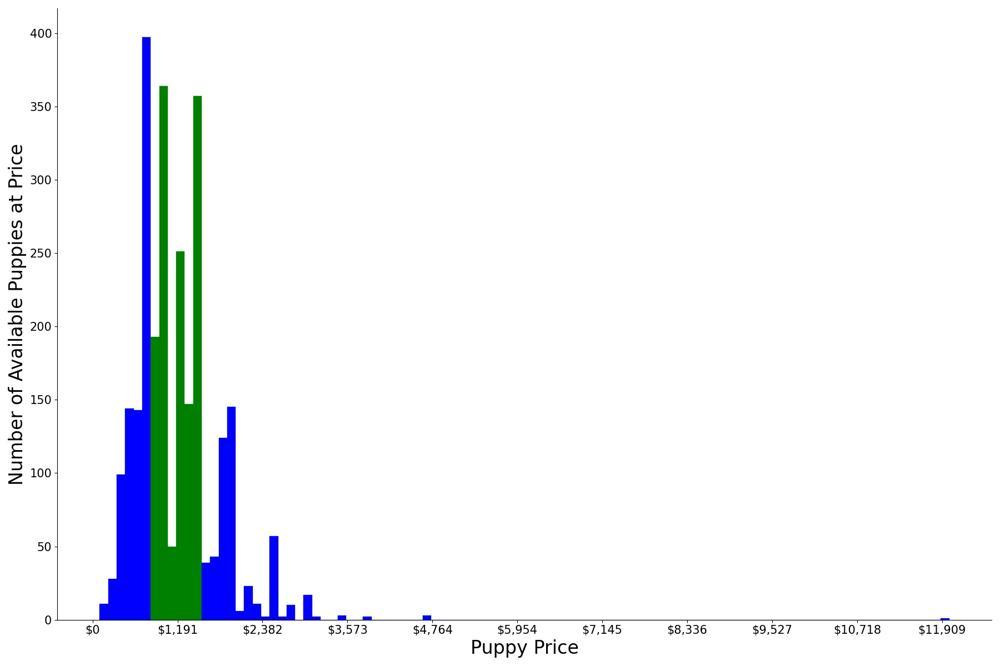
A breakdown of the prices of Australian Shepherds. The typical price range is shaded Green.
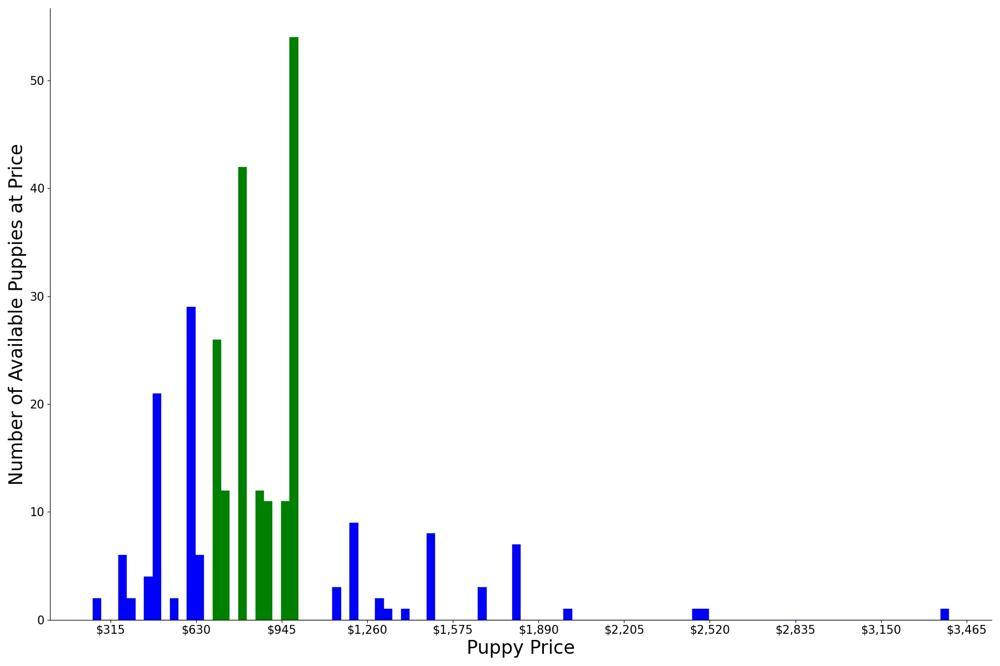
A breakdown of the prices of Bloodhounds
Note that a lot of factors determine how much you can expect to pay for the Australian Shepherd puppy or the Bloodhound puppy. This includes if health screening tests have been performed on the puppy, if the puppy is from a famous pedigree, the US State where the puppy is bred, etc.
Nevertheless, when looking to buy a puppy, look at buying a puppy only from well-established breeders that breed puppies primarily for the love of dogs, and secondarily for profit. Do not buy a puppy from a puppy mill. Puppy mills mass-produce puppies in bad living conditions for maximum profit.
You may also consider adopting a dog instead of buying a dog.

Adopting the Australian Shepherd versus Adopting the Bloodhound
You may consider adopting a dog instead of buying a puppy. Many Australian Shepherds and many Bloodhounds are currently available for adoption.
These adorable and cute dogs are waiting in dog shelters hoping that someday someone will rescue them. Furthermore, adoption costs are lesser than the cost of a new puppy. Dog adoption costs are usually around $300. In addition to your local dog shelter, a good place online to see dogs that are available for adoption is petfinder.com.
Below is an adorable Male Australian Shepherd named 22-096 Rescue Only that is currently available for adoption on Petfinder.com. You can find other lovely adoptable Australian Shepherds like 22-096 Rescue Only on pefinder.com.
Also, like Australian Shepherds, Bloodhounds are also available for adoption. For example, Wiatt is a Male Bloodhound that is currently available for adoption on petfinder.com. You can find more Bloodhounds like Wiatt that are up for adoption on petfinder.com.

Alonzo is the name of another Australian Shepherd (Male) on petfinder.com that is looking for a new home.
Also, Max – Chino Hills Location is an adorable Male Bloodhound on petfinder.com that you can adopt.

You can find more Australian Shepherds and Bloodhounds that are available for adoption on petfinder.
The Popularity of Australian Shepherd versus Popularity of Bloodhound
Every year, the American Kennel Club (AKC) publishes information on how popular a dog breed is in that particular year. The AKC gets the popularity information of a breed from how many dogs of that breed the owners register with the AKC every year. The AKC collects this data for about 200 dog breeds. The AKC collects this data for purebred dogs only(no mixed or hybrid dogs).
The graphs and the table below show the popularity of the Australian Shepherd and the Bloodhound over the years.
Based on the AKC popularity data over the years, the Australian Shepherd is more popular with dog owners than the Bloodhound. This is because, over the years, the average popularity of the Australian Shepherd is 15 out of about 200 dog breeds while the average popularity of the Bloodhound is 49 out of about 200 dog breeds.
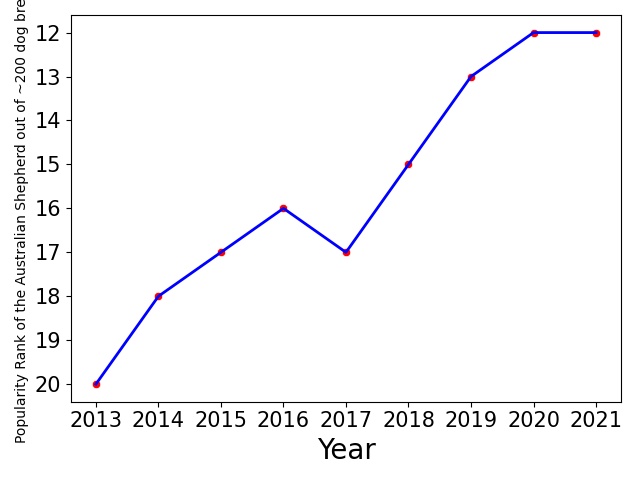
Popularity of Australian Shepherd
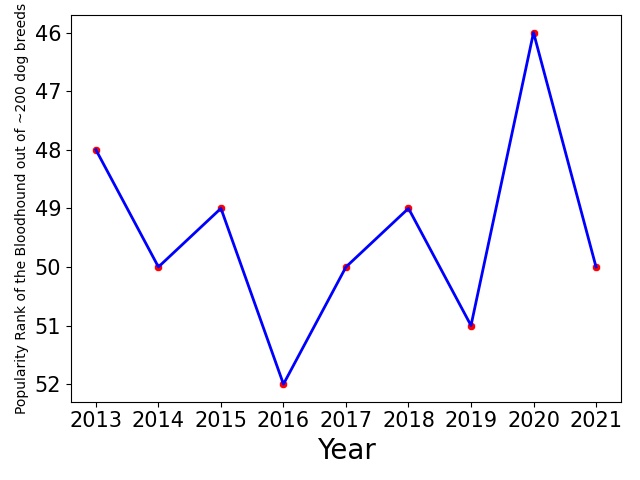
Popularity of Bloodhound
| Year | Australian Shepherd Popularity Rank | Bloodhound Popularity Rank |
|---|---|---|
| 2013 | 20 | 48 |
| 2014 | 18 | 50 |
| 2015 | 17 | 49 |
| 2016 | 16 | 52 |
| 2017 | 17 | 50 |
| 2018 | 15 | 49 |
| 2019 | 13 | 51 |
| 2020 | 12 | 46 |
| 2021 | 12 | 50 |
Health Problems of Australian Shepherd versus Health Problems of Bloodhound
Every dog breed has its own set of health problems that it has a tendency to develop. There is nothing like a perfect dog breed.
Both the Australian Shepherd and the Bloodhound are prone to certain genetic health conditions. The Orthopedic Foundation for Animals (OFA) is the organization that keeps track of health problems in dogs. Based on the extensive records that the OFA keeps, the OFA knows what health problems each dog breed is naturally prone to develop. Hence, the OFA recommends which health screening that breeders should perform on a dog breed to make sure that the breeders won`t breed `defective` dog parents that can pass down defective genes to their puppy offspring.
The more health problems a dog breed is prone to develop, the more health tests the OFA will recommend for that dog breed.
Based on our review of OFA records, we found that the Australian Shepherd is prone to more genetic health problems than the Bloodhound.
This is because the OFA recommends more screening health tests for the Australian Shepherd than for the Bloodhound.
7 health tests are recommended for Australian Shepherd while 6 tests are recommended for the Bloodhound.
Below is a detailed discussion of health problems in Australian Shepherds and in Bloodhounds.
Australian Shepherd Health Problems
Australian Shepherds are genetically prone to certain health problems. However, breeders can reduce the chances of producing Australian Shepherd puppies with genetic defects by making sure that a puppy`s parents are free from genetic health problems before allowing the parent to make puppies.
The OFA provides breeders recommendations on which genetic diseases that breeders should screen their dog parents and puppies for.
If you want a Australian Shepherd puppy that will grow up to be healthy, make sure that your Australian Shepherd breeder screens your puppy or your puppy`s parents for the health problems that the OFA recommends for your puppy`s breed. This will increase the chances that your puppy is free from genetic defects.
The following are the health tests that Orthopedic Foundation for Animals (OFA) recommends that breeders should screen Australian Shepherds for:
You can find out more about OFA`s recommended tests for Australian Shepherds here.
Bloodhound Health Problems
Bloodhounds are genetically prone to certain health problems. However, breeders can reduce the chances of producing Bloodhound puppies with genetic defects by making sure that a puppy`s parents are free from genetic health problems before allowing the parent to make puppies.
The OFA provides breeders recommendations on which genetic diseases that breeders should screen their dog parents and puppies for.
If you want a Bloodhound puppy that will grow up to be healthy, make sure that your Bloodhound breeder screens your puppy or your puppy`s parents for the health problems that the OFA recommends for your puppy`s breed. This will increase the chances that your puppy is free from genetic defects.
The following are the health tests that Orthopedic Foundation for Animals (OFA) recommends that breeders should screen Bloodhounds for:
You can find out more about OFA`s recommended tests for Bloodhounds here.
More Discussions on Health Problems in Australian Shepherds and Bloodhounds
Based on our analysis of data from the Orthopedic Foundation for Animals, of all known genetic health problems in dogs, the health problem that is most commonly seen in the Australian Shepherd Breed is Cataracts problems.
This is because the Australian Shepherd ranks 1 out of 5 dog breeds for Cataracts problems. In fact, in a health test conducted on 107 Australian Shepherds, 2 of them had Cataracts problems.
The genetic diseases that were found to commonly occur in Australian Shepherds, and how common these diseases are in Australian Shepherds relative to other dog breeds, are given below:
Based on our analysis of data from the Orthopedic Foundation for Animals, of all known genetic health problems in dogs, the health problem that is most commonly seen in the Bloodhound Breed is Eyes problems.
This is because the Bloodhound ranks 11 out of 182 dog breeds for Eyes problems. In fact, in a health test conducted on 64 Bloodhounds, 3 of them had Eyes problems.
The genetic diseases that were found to commonly occur in Bloodhounds, and how common these diseases are in Bloodhounds relative to other dog breeds, are given below:
The table below lists the common health problems in Australian Shepherd and in Bloodhound and the rank (prevalence), compared to other dogs, of these health problems in the Australian Shepherd and the Bloodhound:
| Disease | Australian Shepherd Rank | Bloodhound Rank |
|---|---|---|
| Cataracts problems | 1 out of 5 dog breeds | Not Common |
| Multiple Drug Resistance (Mdr1) problems | 2 out of 7 dog breeds | Not Common |
| Progressive Retinal Atrophy problems | 7 out of 32 dog breeds | Not Common |
| Degenerative Myelopathy problems | 12 out of 70 dog breeds | 32 out of 70 dog breeds |
| Shoulder problems | 19 out of 22 dog breeds | Not Common |
| Dentition Database problems | 28 out of 49 dog breeds | Not Common |
| Congenital Cardiac problems | 60 out of 159 dog breeds | 30 out of 159 dog breeds |
| Thyroid problems | 66 out of 115 dog breeds | 39 out of 115 dog breeds |
| Elbow problems | 77 out of 144 dog breeds | 30 out of 144 dog breeds |
| Patella problems | 103 out of 145 dog breeds | 66 out of 145 dog breeds |
| Eyes problems | 133 out of 182 dog breeds | 11 out of 182 dog breeds |
| Hips problems | 150 out of 198 dog breeds | 26 out of 198 dog breeds |
| Advanced Cardiac problems | Not Common | 14 out of 71 dog breeds |
*To learn more about each of these diseases, go to OFA.org and search for the disease.
Again, most of these health problems can be prevented through health screening. Responsible breeders screen male and female dog parents for genetic problems. These breeders will only breed dogs that are free of genetic defects. That way, there is little or no chance that their puppies will grow up to have genetic health problems. Always ask a breeder for the list of health tests the breeder screens their dogs for before buying a puppy from such a breeder.
Tolerates Being Alone: Australian Shepherd versus Bloodhound
Australian Shepherds do not like to be left alone.
Bloodhounds do not like to be left alone.
Do Australian Shepherds shed more than Bloodhounds?
Australian Shepherds shed moderately.
Bloodhounds shed. They are not recommended for people with dog allergies.
Which is Easier to Groom, the Australian Shepherd or the Bloodhound?
Australian Shepherds require a lot of grooming and they are not very easy to groom.
Bloodhounds require a lot of grooming and they are not very easy to groom.
Which Dog Breed is more Dog-Friendly, the Australian Shepherd or the Bloodhound?
Australian Shepherds get along very well with other dogs.
Bloodhounds get along very well with other dogs.
Are Australian Shepherds good family dogs? What about Bloodhounds?
Australian Shepherds are great family dogs. They are very affectionate with family.
Bloodhounds are great family dogs. They are very affectionate with family.
Is the Australian Shepherd Easier to Train than the Bloodhound?
Australian Shepherds are very easy to train.
Bloodhounds are fairly easy to train.
Which one drools more, the Australian Shepherd or the Bloodhound
Australian Shepherds do have a very low tendency to drool.
Bloodhounds have a very high tendency to drool.
How Kid-friendly are Australian Shepherds and Bloodhounds?
Australian Shepherds get along well with kids. They are kid-friendly.
Bloodhounds get along well with kids. They are kid-friendly.
Does the Australian Shepherd Have a Higher Prey Drive than the Bloodhound?
Australian Shepherds have a high prey drive. They have the tendency to chase after smaller animals and pets. They do not get along well with other pets.
Bloodhounds have a moderate prey drive. They can sometimes chase after smaller animals and pets.
Do Australian Shepherds Bark and Howl? What about Bloodhounds?
Australian Shepherds are highly vocal. They have the tendency to bark and howl.
Bloodhounds are highly vocal. They have the tendency to bark and howl.
Can Australian Shepherds Tolerate Cold Weather? And can Bloodhounds Tolerate Cold Weather?
Australian Shepherds can very well tolerate cold weather.
Bloodhounds can moderately tolerate cold weather.
Wanderlust Potential: Australian Shepherd vs. Bloodhound
Australian Shepherds have a high tendency to wander. They are easily distracted by other animals or objects.
Bloodhounds have a high tendency to wander. They are easily distracted by other animals or objects.
Can Australian Shepherds Tolerate Hot Weather? Can Bloodhounds Tolerate Hot Weather?
Australian Shepherds can tolerate hot weather.
Bloodhounds can tolerate hot weather as long as the weather is not too hot.
Is the Australian Shepherd Better for Apartment Owners than the Bloodhound?
Australian Shepherds do not adapt well to apartment living.
Bloodhounds do not adapt well to apartment living.
Which is Better for New Dog Owners, the Australian Shepherd or the Bloodhound?
Australian Shepherds are not the best dogs for new dog owners.
Bloodhounds are not the best dogs for new dog owners.
Australian Shepherd Versus Other Dog Breeds
You may also be interested in how the Australian Shepherd compares to other breeds aside from the Bloodhound. So, see below the links to the comparison of the Australian Shepherd to other breeds:
Australian Shepherd versus Bedlington Terrier Australian Shepherd versus Redbone Coonhound Australian Shepherd versus Finnish Spitz Australian Shepherd versus Italian Greyhound Australian Shepherd versus Cavalier King Charles Spaniel Australian Shepherd versus Australian Cattle Dog Australian Shepherd versus Boerboel Australian Shepherd versus Afghan Hound Australian Shepherd versus Korean Jindo Dog Australian Shepherd versus Boykin Spaniel Australian Shepherd versus Sealyham Terrier Australian Shepherd versus Border Collie Australian Shepherd versus Mudi Australian Shepherd versus Flat-Coated Retriever Australian Shepherd versus German Shorthaired Pointer
Conclusion: Australian Shepherd versus Bloodhound. Which One is a Better Pet?
In summary, there is nothing like a better dog breed or a worse dog breed. The important question to ask is which dog breed better matches your interests and lifestyle. We hope our discussion above will help you in deciding which dog breed between the Australian Shepherd and the Bloodhound better suits you and your family.
